Dealing with Dust: Floor Sanding and Clean-Up Tips
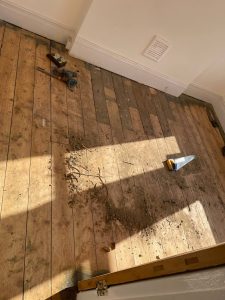
Ensure a Clean and Healthy Environment in Your London Home
Introduction
Floor sanding is a great way to rejuvenate your wooden floors, but it can generate a significant amount of dust. Properly managing and cleaning up dust is essential to maintain a healthy and clean environment in your London home. This guide provides effective tips for dealing with dust during and after floor sanding.
Preparation Before Sanding
Proper preparation can help minimise dust during the sanding process:
- Seal Off the Area: Use plastic sheeting to seal off doorways, windows, and vents in the room being sanded. This prevents dust from spreading to other parts of your home.
- Remove Furniture and Belongings: Clear the room of all furniture and personal items to protect them from dust. Cover any immovable items with plastic sheets.
- Wear Protective Gear: Use a dust mask, safety goggles, and ear protection to safeguard yourself from dust and noise during sanding.
Using Dust-Controlled Sanding Equipment

Investing in dust-controlled sanding equipment can significantly reduce dust production:
- Dust Containment Systems: Modern sanding machines often come with built-in dust containment systems that capture dust as it is produced.
- Vacuum Attachments: Attach a vacuum to your sander to collect dust directly at the source. This keeps the air cleaner and reduces the amount of dust settling on surfaces.
During Sanding
While sanding, take steps to manage dust effectively:
- Keep the Sander Moving: Avoid staying in one spot for too long to prevent excessive dust accumulation and ensure an even sanding job.
- Regularly Empty Dust Bags: If your sander has a dust bag, empty it frequently to maintain its efficiency.
- Ventilate the Area: Open windows and use fans to create airflow that helps carry dust out of the room.
Post-Sanding Clean-Up
After sanding, thorough cleaning is crucial to remove all dust from your home:
- Vacuum Thoroughly: Use a vacuum cleaner with a HEPA filter to capture fine dust particles. Vacuum all surfaces, including walls, ceilings, and floors.
- Wipe Down Surfaces: Use a damp cloth to wipe down all surfaces, including countertops, windowsills, and baseboards, to remove any remaining dust.
- Mop the Floor: After vacuuming, use a damp mop to clean the floor. This helps pick up any dust missed by the vacuum cleaner.
- Clean Air Filters: Check and clean or replace air filters in your HVAC system to ensure they are not circulating dust throughout your home.
Maintaining a Dust-Free Environment
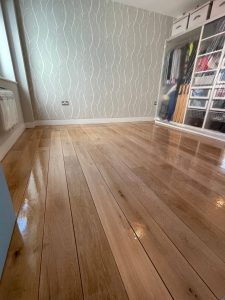
To keep your home dust-free after sanding:
- Regular Cleaning: Regularly vacuum and dust your home to prevent dust buildup. Use a vacuum with a HEPA filter for the best results.
- Use Doormats: Place doormats at entrances to reduce the amount of dust and dirt brought into your home.
- Maintain Proper Humidity: Use a humidifier or dehumidifier to maintain optimal indoor humidity levels, as proper humidity can reduce dust accumulation.


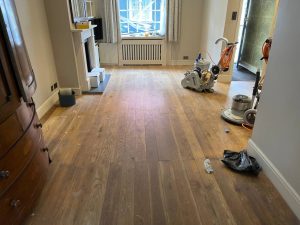

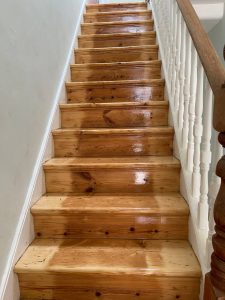
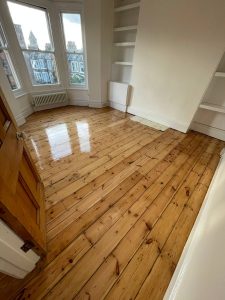

How to Handle Floor Stains from Spills and Accidents
How to Handle Floor Stains from Spills and Accidents Spills and accidents are inevitable,[Read more...]
Wood floor polishing
[Read more...]
How to Achieve a Smooth Finish on Your Sanded Floors
How to Achieve a Smooth Finish on Your Sanded Floors Expert Tips for Professional-Quality[Read more...]
Floor sanding and renovation and installation services in Croydon
Croydon: A Dynamic and Diverse London Borough Croydon is a bustling and diverse borough located[Read more...]
CLT Panels: A Modern Solution for Floor Restoration
CLT Panels: A Modern Solution for Floor Restoration At Alchemist Floor Sanding, we aim[Read more...]
The Importance of Grain Direction in Floor Sanding
The Importance of Grain Direction in Floor Sanding When it comes to floor sanding,[Read more...]
Floor Board Fitting
Installing, Fitting, sanding and finishing different types of flooring takes a lot of work. when[Read more...]
Sep
Polishing the floor in london
[Read more...]
How to Incorporate Floor Sanding into Your DIY Projects
How to Incorporate Floor Sanding into Your DIY Projects For London homeowners looking to[Read more...]
Expert Tips for Maintaining Sanded Floors
Sanding your wooden floors can breathe new life into your home, giving it a fresh,[Read more...]